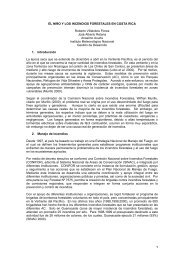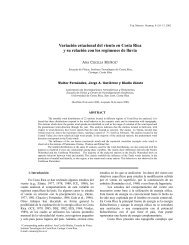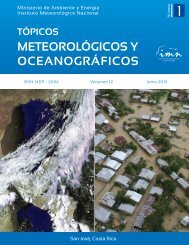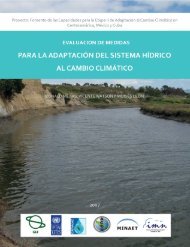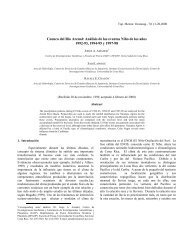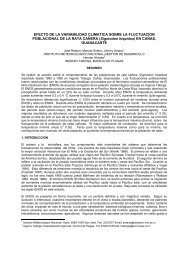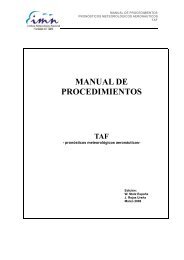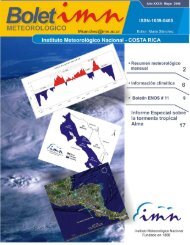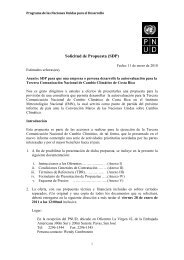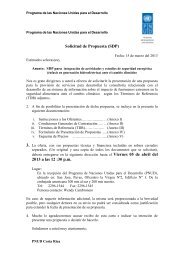descargar Documento - IMN - Instituto Meteorológico Nacional
descargar Documento - IMN - Instituto Meteorológico Nacional
descargar Documento - IMN - Instituto Meteorológico Nacional
You also want an ePaper? Increase the reach of your titles
YUMPU automatically turns print PDFs into web optimized ePapers that Google loves.
38<br />
b) Meteorological radar network, which<br />
would greatly improve rain and river flow<br />
forecasting, specifically supporting the assessment<br />
of floods.<br />
c) Forest fires network, to enhance prevention<br />
through constant monitoring of soil<br />
humidity and temperature, and humidity<br />
of combustible material. It should be<br />
installed jointly between ICE and the national<br />
System for Conservation Areas (SI-<br />
NAC).<br />
d) Water quality network, as there is no<br />
doubt that water quality measurements in<br />
bodies of water such as rivers, lakes, and<br />
reservoirs have been omitted from the climate<br />
and hydrometeorological network.<br />
The establishment of a climate change network<br />
requires the installation of pattern weather stations,<br />
that should a) have more precise instruments<br />
than the ones currently being used; b) be<br />
periodically calibrated against pattern instruments,<br />
in order to ensure data quality throughout<br />
time; c) be placed in sites that are not disturbed<br />
by situations foreign to climate; d) have<br />
easy access to spare parts in order to give constant<br />
maintenance; e) be inserted into regional<br />
networks in order to ensure compatibility with<br />
that of other countries.<br />
Two ocean buoys will be installed in upcoming<br />
years in open waters off the country’s coast both<br />
in the Caribbean as in the Pacific, in order to<br />
monitor wind, sea level, salinity, and sea surface<br />
temperature.<br />
With regard to atmospheric pollution, the network<br />
should measure the following variables:<br />
carbon monoxide (CO), carbon dioxide (CO 2<br />
),<br />
nitrogen dioxide (NO 2<br />
), sulfur dioxide (SO 2<br />
), hydrogen<br />
sulfide (H 2<br />
S), superficial ozone (O 3<br />
, and<br />
methane (CH 4<br />
).<br />
Other relevant information to achieve<br />
the objectives of the Convention<br />
This section summarizes common elements among<br />
the three Conventions.<br />
a) Legal perspective: Officials responsible for<br />
the implementation of international environmental<br />
Conventions consider that there is no<br />
need to enact additional domestic legislation<br />
to improve or enhance such implementation.<br />
In general, the existing legal framework is adequate,<br />
although there is a need to strengthen<br />
the legal and institutional mechanisms and<br />
build on political will to ensure effective compliance,<br />
in particular for the constitutional recognition<br />
of international conventions as higher<br />
ranked than domestic laws.<br />
b) Political perspective: Main difficulties for the<br />
effective implementation of global environmental<br />
agreements are related to the lack of<br />
incorporation of international obligations and<br />
responsibilities within national policies and<br />
planning processes. This limitation are linked<br />
to the lack of appropriate mechanisms for sectorial<br />
coordination that will promote an integral<br />
development pathway.<br />
c) Institutional perspective: there is a lack of appropriate<br />
coordination mechanisms among<br />
the different sectors and institutions responsible<br />
for the implementation of international<br />
environmental agreements. Responsibilities<br />
and institutional functions are not clearly established<br />
causing overlapping and gaps in improving<br />
actions efficiently.<br />
d) Operational limitations: there are no appropriate<br />
indicators to measure political<br />
impacts and the efficiency of the implementation<br />
of international Conventions.<br />
e) Financial limitations: there is not a formal<br />
public planning process to include in the<br />
national budget the cost of putting into effect<br />
actions, plans and programs according<br />
to the implementation of international<br />
commitments.<br />
II Comunicación <strong>Nacional</strong> 2009



